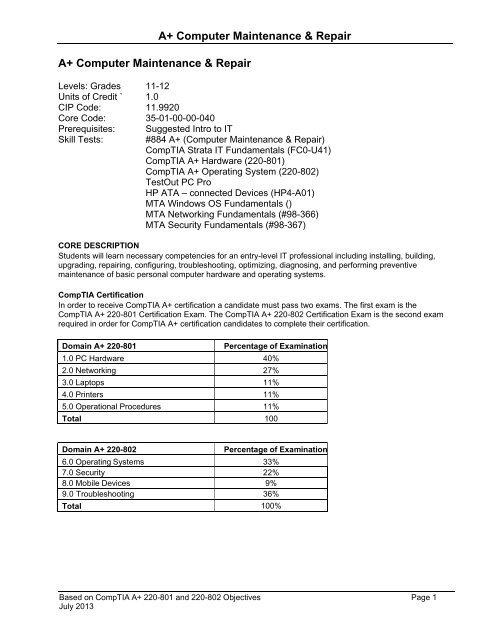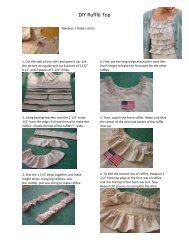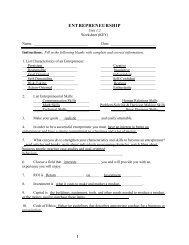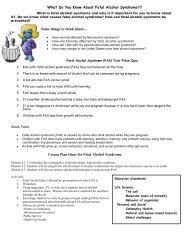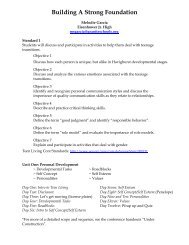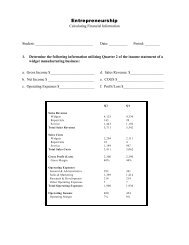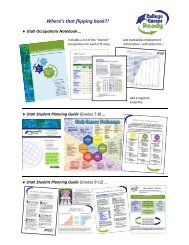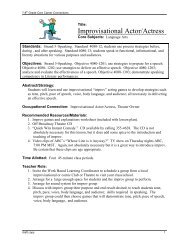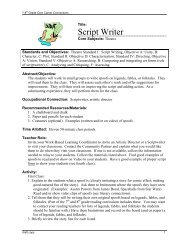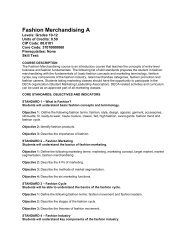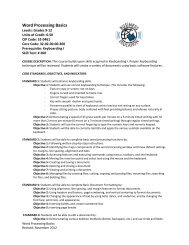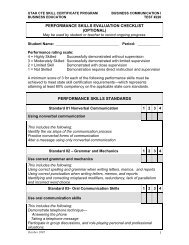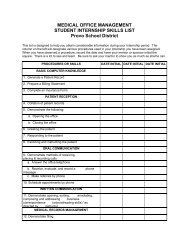CompTIA A+ Essentials (2009 Edition) ...
CompTIA A+ Essentials (2009 Edition) ...
CompTIA A+ Essentials (2009 Edition) ...
You also want an ePaper? Increase the reach of your titles
YUMPU automatically turns print PDFs into web optimized ePapers that Google loves.
<strong>A+</strong> Computer Maintenance & Repair<br />
Levels: Grades 11-12<br />
Units of Credit ` 1.0<br />
CIP Code: 11.9920<br />
Core Code: 35-01-00-00-040<br />
Prerequisites:<br />
Skill Tests:<br />
<strong>A+</strong> Computer Maintenance & Repair<br />
Suggested Intro to IT<br />
#884 <strong>A+</strong> (Computer Maintenance & Repair)<br />
<strong>CompTIA</strong> Strata IT Fundamentals (FC0-U41)<br />
<strong>CompTIA</strong> <strong>A+</strong> Hardware (220-801)<br />
<strong>CompTIA</strong> <strong>A+</strong> Operating System (220-802)<br />
TestOut PC Pro<br />
HP ATA – connected Devices (HP4-A01)<br />
MTA Windows OS Fundamentals ()<br />
MTA Networking Fundamentals (#98-366)<br />
MTA Security Fundamentals (#98-367)<br />
CORE DESCRIPTION<br />
Students will learn necessary competencies for an entry-level IT professional including installing, building,<br />
upgrading, repairing, configuring, troubleshooting, optimizing, diagnosing, and performing preventive<br />
maintenance of basic personal computer hardware and operating systems.<br />
<strong>CompTIA</strong> Certification<br />
In order to receive <strong>CompTIA</strong> <strong>A+</strong> certification a candidate must pass two exams. The first exam is the<br />
<strong>CompTIA</strong> <strong>A+</strong> 220-801 Certification Exam. The <strong>CompTIA</strong> <strong>A+</strong> 220-802 Certification Exam is the second exam<br />
required in order for <strong>CompTIA</strong> <strong>A+</strong> certification candidates to complete their certification.<br />
Domain <strong>A+</strong> 220-801<br />
Percentage of Examination<br />
1.0 PC Hardware 40%<br />
2.0 Networking 27%<br />
3.0 Laptops 11%<br />
4.0 Printers 11%<br />
5.0 Operational Procedures 11%<br />
Total 100<br />
Domain <strong>A+</strong> 220-802<br />
Percentage of Examination<br />
6.0 Operating Systems 33%<br />
7.0 Security 22%<br />
8.0 Mobile Devices 9%<br />
9.0 Troubleshooting 36%<br />
Total 100%<br />
Based on <strong>CompTIA</strong> <strong>A+</strong> 220-801 and 220-802 Objectives Page 1<br />
July 2013
<strong>A+</strong> Computer Maintenance & Repair<br />
<strong>CompTIA</strong> 801-201<br />
Standard 1.0 PC Hardware<br />
1.1 Configure and apply BIOS Settings.<br />
Install firmware upgrades – flash BIOS<br />
BIOS component information<br />
o RAM<br />
o Hard drive<br />
o Optical drive<br />
o CPU<br />
BIOS configurations<br />
o Boot sequence<br />
o Enabling and disabling devices<br />
o Date/time<br />
o Clock speeds<br />
o Virtualization support<br />
BIOS security (passwords, drive encryption: TPM, lo-jack)<br />
Use built-in diagnostics<br />
Monitoring<br />
o Temperature monitoring<br />
o Fan speeds<br />
o Intrusion detection/notification<br />
o Voltage<br />
o Clock<br />
o Bus speed<br />
1.2 Differentiate between motherboard components, their purposes, and properties.<br />
Sizes<br />
o ATX<br />
o Micro –ATX<br />
o ITX<br />
Expansion slots<br />
o PCI<br />
o PCI-X<br />
o PCIe<br />
o miniPCI<br />
o CNR<br />
o AGP2x, 4x, 8x<br />
RAM slots<br />
CPU sockets<br />
Chipsets<br />
o North Bridge<br />
o South Bridge<br />
o CMOS battery<br />
Jumpers<br />
Power connections and types<br />
Fan connectors<br />
Front panel connectors<br />
o USB<br />
o Audio<br />
o Power button<br />
o Power light<br />
o Drive activity lights<br />
o Reset button<br />
Bus speeds<br />
1.3 Compare and contrast RAM types and features.<br />
Types<br />
o DDR<br />
Based on <strong>CompTIA</strong> <strong>A+</strong> 220-801 and 220-802 Objectives Page 2<br />
July 2013
<strong>A+</strong> Computer Maintenance & Repair<br />
o DDR2<br />
o SDRAM<br />
o SODIMM<br />
o DIMM<br />
o RAM configurations (Single channel vs dual channel vs triple channel)<br />
RAM compatibility and speed<br />
1.4 Install and configure expansion cards.<br />
Sound cards<br />
Video cards<br />
Network cards<br />
Serial and parallel cards<br />
USB cards<br />
Firewire cards<br />
Storage cards<br />
Modem cards<br />
Wireless/cellular cards<br />
TV tuner cards<br />
Video capture cards<br />
Riser cards<br />
1.5 Install and configure storage devices and use appropriate media.<br />
Optical drives<br />
o CD-ROM<br />
o DVD-ROM<br />
o Blu-Ray<br />
Combo drives and burners<br />
o CD-RW<br />
o DVD-RW<br />
o Dual Layer DVD-RW<br />
o BD-R<br />
o BD-RE<br />
Connection types<br />
o External (USB, Firewire, eSATA, Ethernet)<br />
o Internal SATA, IDE and SCSI (IDE configuration and setup (Master, Slave, Cable<br />
Select), SCSI IDs (0 – 15))<br />
o Hot swappable drives<br />
Hard drives<br />
o Magnetic<br />
o 5400 rpm<br />
o 7200 rpm<br />
o 10,000 rpm<br />
o 15,000 rpm<br />
Solid state/flash drives<br />
o Compact flash<br />
o SD<br />
o Micro-SD<br />
o Mini-SD<br />
o xD<br />
o SSD<br />
RAID types (0, 1, 5, 10)<br />
Media capacity<br />
o CD<br />
o CD-RW<br />
o DVD-RW<br />
o DVD<br />
o Blu-Ray<br />
o DL DVD<br />
Based on <strong>CompTIA</strong> <strong>A+</strong> 220-801 and 220-802 Objectives Page 3<br />
July 2013
<strong>A+</strong> Computer Maintenance & Repair<br />
1.6 Differentiate among various CPU types and features and select the appropriate cooling<br />
method.<br />
Socket types<br />
o Intel: LGA, 775, 1155, 1156, 1366<br />
o AMD: 940, AM2, AM2+, AM3, AM3+, FM1, F<br />
Characteristics<br />
o Speeds<br />
o Cores<br />
o Cache size/type<br />
o Hyperthreading<br />
o Architecture (32-bit vs. 64-bit)<br />
o Integrated GPU<br />
Cooling<br />
o Heat sink<br />
o Fans<br />
o Thermal paste<br />
1.7 Compare and contrast various connection interfaces and explain their purpose.<br />
Physical connections<br />
o USB 1.1 vs. 2.0 vs. 3.0 characteristics (Connector types: A, B, mini, micro)<br />
o Firewire characteristics<br />
o SATA1 vs. SATA2 vs. SATA3, eSATA, IDE speeds<br />
o Other connector types (Serial, Parallel, VGA, HDMI, DVI, Audio, RJ-45, RJ-11)<br />
o Analog vs. digital transmission<br />
VGA vs. HDMI<br />
Speeds, distances and frequencies of wireless device connections<br />
o Bluetooth<br />
o RF (802.11 )<br />
1.8 Install an appropriate power supply based on a given scenario.<br />
Connector types and their voltages<br />
o SATA<br />
o Molex<br />
o 4/8-pin 12v<br />
o PCIe 6/8-pin<br />
o 20-pin<br />
o 24-pin<br />
o Floppy<br />
Specifications<br />
o Wattage<br />
o Size<br />
o Number of connectors<br />
o ATX<br />
o Micro-ATX<br />
Dual voltage options<br />
1.9 Evaluate and select appropriate components for a custom configuration, to meet customer<br />
specifications or needs.<br />
Graphic / CAD / CAM design workstation<br />
Audio/Video editing workstation<br />
Virtualization workstation<br />
Gaming PC<br />
Home Theater PC<br />
Standard thick client<br />
Thin client<br />
Home Server PC<br />
1.10 Given a scenario, evaluate types and features of display devices.<br />
Types<br />
o CRT<br />
o LCD<br />
o LED<br />
Based on <strong>CompTIA</strong> <strong>A+</strong> 220-801 and 220-802 Objectives Page 4<br />
July 2013
<strong>A+</strong> Computer Maintenance & Repair<br />
o Projector<br />
Resolution<br />
Native resolution<br />
Analog vs. digital<br />
Privacy/antiglare filters<br />
Multiple displays<br />
1.11 Identify connector types and associated cables.<br />
Display connector types<br />
o DVI-D<br />
o DVI-I<br />
o DVI-A<br />
o DisplayPort<br />
o HD15 (i.e. DE15 or DB15)<br />
o miniHDMI<br />
o RJ-45<br />
o miniDin-6<br />
Display cable types<br />
o HDMI<br />
o DVI<br />
o VGA<br />
o Component<br />
o Composite<br />
o S-video<br />
o Coaxial<br />
o Ethernet<br />
Device connectors and pin arrangements<br />
o SATA<br />
o eSATA<br />
o PATA<br />
o IDE<br />
o EIDE<br />
o USB<br />
o IEEE1394<br />
o SCSI<br />
o PS/2<br />
o Parallel<br />
o Serial<br />
o Audio<br />
o RJ-45<br />
Device cable types<br />
o SATA<br />
o eSATA<br />
o IDE<br />
o EIDE<br />
o Floppy<br />
o USB<br />
o IEEE1394<br />
o SCSI (68pin vs. 50pin vs. 25pin)<br />
o Parallel<br />
o Serial<br />
o Ethernet<br />
o Phone<br />
1.12 Install and configure various peripheral devices.<br />
Input devices<br />
o Mouse<br />
o Keyboard<br />
o Microphone<br />
Based on <strong>CompTIA</strong> <strong>A+</strong> 220-801 and 220-802 Objectives Page 5<br />
July 2013
<strong>A+</strong> Computer Maintenance & Repair<br />
<br />
Output devices<br />
o Printers<br />
o Speakers<br />
o Display devices<br />
Standard 2.0 Networking<br />
2.1 Identify types of network cables and connectors.<br />
Twisted Pair<br />
o Connectors: RJ-11, RJ-45<br />
o Wiring standards: T568A, T568B<br />
2.2 Categorize characteristics of connectors and cabling.<br />
Twisted pair<br />
o Types: STP, UTP, CAT3, CAT5, CAT5e, CAT6, plenum, PVC<br />
o Speed and transmission limitations<br />
2.3 Explain properties and characteristics of TCP/IP.<br />
IP class<br />
o Class A<br />
o Class B<br />
o Class C<br />
IPv4 vs. IPv6<br />
Public vs. private vs. APIPA<br />
Static vs. dynamic<br />
Client-side DNS<br />
DHCP<br />
Subnet mask<br />
Gateway<br />
2.4 Explain common TCP and UDP ports, protocols, and their purpose.<br />
Ports<br />
o 21 – FTP<br />
o 23 – TELNET<br />
o 25 – SMTP<br />
o 53 – DNS<br />
o 80 – HTTP<br />
o 110 – POP3<br />
o 143 – IMAP<br />
o 443 – HTTPS<br />
o 3389 – RDP<br />
Protocols<br />
o DHCP<br />
o DNS<br />
o LDAP<br />
o SNMP<br />
o SMB<br />
o SSH<br />
o SFTP<br />
TCP vs. UDP<br />
2.5 Compare and contrast wireless networking standards and encryption types.<br />
Standards<br />
o 802.11 a/b/g/n<br />
o Speeds, distances and frequencies<br />
Encryption types<br />
o WEP, WPA, WPA2, TKIP, AES<br />
2.6 Install, configure, and deploy a SOHO wireless/wired router using appropriate settings.<br />
MAC filtering<br />
Channels (1 – 11)<br />
Port forwarding, port triggering<br />
SSID broadcast (on/off)<br />
Wireless encryption<br />
Based on <strong>CompTIA</strong> <strong>A+</strong> 220-801 and 220-802 Objectives Page 6<br />
July 2013
<strong>A+</strong> Computer Maintenance & Repair<br />
Firewall<br />
DHCP (on/off)<br />
DMZ<br />
NAT<br />
2.7 Compare and contrast Internet connection types and features.<br />
Cable<br />
DSL<br />
Dial-up<br />
Fiber<br />
Cellular (mobile hotspot)<br />
2.8 Identify various types of networks.<br />
LAN<br />
WAN<br />
PAN<br />
MAN<br />
Topologies<br />
o Ring<br />
o Bus<br />
o Star<br />
o Hybrid<br />
2.9 Compare and contrast network devices their functions and features.<br />
Hub<br />
Switch<br />
o PoE<br />
Router<br />
Access point<br />
Bridge<br />
Modem<br />
NAS<br />
Firewall<br />
VoIP phones<br />
Internet appliance<br />
2.10 Given a scenario, use appropriate networking tools.<br />
Crimper<br />
Multimeter<br />
Toner probe<br />
Cable tester<br />
Loopback plug<br />
Punchdown tool<br />
Standard 3.0 Laptops (Deleted)<br />
Standard 4.0 Printers<br />
4.1 Explain the differences between the various printer types and summarize the associated<br />
imaging process.<br />
Laser<br />
o Imaging drum, fuser assembly, transfer belt, transfer roller, pickup rollers, separate<br />
pads, duplexing assembly<br />
o Imaging process: processing, charging, exposing, developing, transferring, fusing<br />
and cleaning<br />
Inkjet<br />
o Ink cartridge, print head, roller, feeder, duplexing assembly, carriage and belt<br />
o Calibration<br />
Thermal<br />
o Feed assembly, heating element<br />
o Special thermal paper<br />
4.2 Given a scenario, install, and configure printers.<br />
Use appropriate printer drivers for a given operating system<br />
Based on <strong>CompTIA</strong> <strong>A+</strong> 220-801 and 220-802 Objectives Page 7<br />
July 2013
<strong>A+</strong> Computer Maintenance & Repair<br />
Print device sharing<br />
o Wired (USB, Parallel, Ethernet)<br />
o Wireless (802.11x)<br />
o Printer hardware print server<br />
Printer sharing<br />
o Sharing local/networked printer via Operating System settings<br />
4.3 Given a scenario, perform printer maintenance.<br />
Laser<br />
o Replacing toner, applying maintenance kit, calibration, cleaning<br />
Standard 5.0 Operational Procedures<br />
5.1 Given a scenario, use appropriate safety procedures.<br />
ESD straps<br />
ESD mats<br />
Self-grounding<br />
Equipment grounding<br />
Personal safety<br />
o Disconnect power before repairing PC<br />
o Remove jewelry<br />
o Lifting techniques<br />
o Weight limitations<br />
o Electrical fire safety<br />
o CRT safety – proper disposal<br />
o Cable management<br />
Compliance with local government regulations<br />
5.2 Explain environmental impacts and the purpose of environmental controls.<br />
MSDS documentation for handling and disposal<br />
Power surges, brownouts, blackouts<br />
o Battery backup<br />
o Surge suppressor<br />
Dust and debris<br />
o Compressed air<br />
o Vacuums<br />
Component handling and protection<br />
o Antistatic bags<br />
Compliance to local government regulations<br />
5.3 Given a scenario, demonstrate proper communication and professionalism.<br />
Use proper language – avoid jargon, acronyms, slang when applicable<br />
Maintain a positive attitude<br />
Listen and do not interrupt the customer<br />
Be culturally sensitive<br />
Be on time (if late contact the customer)<br />
Avoid distractions<br />
o Personal calls<br />
o Talking to co-workers while interacting with customers<br />
o Personal interruptions<br />
Dealing with difficult customer or situation<br />
o Avoid arguing with customers and/or being defensive<br />
o Do not minimize customer’s problems<br />
o Avoid being judgmental<br />
o Clarify customer statements (ask open ended questions to narrow the scope of the<br />
problem, restate the issue or question to verify understanding)<br />
Set and meet expectations/timeline and communicate status with the customer<br />
o Offer different repair/replacement options if applicable<br />
o Provide proper documentation on the services provided<br />
o Follow up with customer/user at a later date to verify satisfaction<br />
Deal appropriately with customers confidential materials<br />
Based on <strong>CompTIA</strong> <strong>A+</strong> 220-801 and 220-802 Objectives Page 8<br />
July 2013
<strong>A+</strong> Computer Maintenance & Repair<br />
o Located on a computer, desktop, printer, etc<br />
5.4 Explain the fundamentals of dealing with prohibited content/activity.<br />
First response<br />
o Identify<br />
o Report through proper channels<br />
o Data/device preservation<br />
Use of documentation/documentation changes<br />
Chain of custody<br />
o Tracking of evidence/documenting process<br />
<strong>CompTIA</strong> 801-202<br />
Standard 6.0 Operating Systems<br />
6.1 Compare and contrast the features and requirements of various Microsoft Operating<br />
Systems.<br />
Windows XP Home, Windows XP Professional, Windows XP Media Center, Windows XP 64-bit<br />
Professional<br />
Windows Vista Home Basic, Windows Vista Home Premium, Windows Vista Business,<br />
Windows Vista Ultimate, Windows Vista Enterprise<br />
Windows 7 Starter, Windows 7 Home Premium, Windows 7 Professional, Windows 7<br />
Ultimate, Windows 7 Enterprise<br />
Features:<br />
o 32-bit vs. 64-bit<br />
o Aero, gadgets, user account control, bit-locker, shadow copy, system restore, ready<br />
boost, sidebar, compatibility mode, XP mode, easy transfer, administrative tools,<br />
defender, Windows firewall, security center, event viewer, file structure and paths,<br />
category view vs. classic view<br />
Upgrade paths – differences between in place upgrades, compatibility tools, Windows upgrade<br />
OS advisor<br />
6.2 Given a scenario, install, and configure the operating system using the most appropriate<br />
method.<br />
Boot methods<br />
o USB<br />
o CD-ROM<br />
o DVD<br />
o PXE<br />
Type of installations<br />
o Creating image<br />
o Unattended installation<br />
o Upgrade<br />
o Clean install<br />
o Repair installation<br />
o Multiboot<br />
o Remote network installation<br />
o Image deployment<br />
Partitioning<br />
o Dynamic<br />
o Basic<br />
o Primary<br />
o Extended<br />
o Logical<br />
File system types/formatting<br />
o FAT32<br />
o NTFS<br />
o CDFS<br />
o Quick format vs. full format<br />
Based on <strong>CompTIA</strong> <strong>A+</strong> 220-801 and 220-802 Objectives Page 9<br />
July 2013
<strong>A+</strong> Computer Maintenance & Repair<br />
Load alternate third party drivers when necessary<br />
Workgroup vs. Domain setup<br />
Driver installation, software and windows updates<br />
Factory recovery partition<br />
6.3 Given a scenario, use appropriate command line tools.<br />
Networking<br />
o PING<br />
o TRACERT<br />
o IPCONFIG<br />
o NSLOOKUP<br />
OS<br />
o MD<br />
o RD<br />
o CD<br />
o DEL<br />
o FDISK<br />
o FORMAT<br />
o COPY<br />
o XCOPY<br />
o CHKDSK<br />
o [command name] /?<br />
Recovery console<br />
o Fixboot<br />
o Fixmbr<br />
6.4 Given a scenario, use appropriate operating system features and tools.<br />
Administrative<br />
o Computer management<br />
o Device manager<br />
o Users and groups<br />
o Local security policy<br />
o Performance monitor<br />
o Services<br />
o System configuration<br />
o Component services<br />
o Windows firewall<br />
o Advanced security<br />
MSCONFIG<br />
o General<br />
o Boot<br />
o Service<br />
o Startup<br />
o Tools<br />
Task Manager<br />
o Applications<br />
o Processes<br />
o Performance<br />
o Networking<br />
o Users<br />
Run line utilities<br />
o MSCONFIG<br />
o REGEDIT<br />
o CMD<br />
o SERVICES.MSC<br />
o MMC<br />
o MSTSC<br />
o NOTEPAD<br />
o EXPLORER<br />
o MSINFO32<br />
Based on <strong>CompTIA</strong> <strong>A+</strong> 220-801 and 220-802 Objectives Page 10<br />
July 2013
<strong>A+</strong> Computer Maintenance & Repair<br />
6.5 Given a scenario, use Control Panel utilities (the items are organized by “classic view/large<br />
icons” in Windows).<br />
Common to all Microsoft Operating Systems<br />
o Internet options (Security, General, Privacy, Advanced)<br />
o Display (Resolution)<br />
o User accounts<br />
o Folder options (Sharing, View hidden files, Hide extensions, Layout)<br />
o System (Performance (virtual memory), Hardware profiles, Remote settings,<br />
Windows firewall)<br />
o Power options (Hibernate, Power plans, Sleep/suspend, Standby)<br />
Unique to Windows XP<br />
o Add/remove programs<br />
o Network connections<br />
o Printers and faxes<br />
o Automatic updates<br />
o Network setup wizard<br />
Unique to Windows 7<br />
o HomeGroup<br />
o Action center<br />
o Remote applications and desktop applications<br />
o Troubleshooting<br />
6.6 Setup and configure Windows networking on a client/desktop.<br />
HomeGroup, file/print sharing<br />
WorkGroup<br />
Network shares/mapping drives<br />
Establish networking connections<br />
o VPN<br />
o Dialups<br />
o Wireless<br />
o Wired<br />
o WWAN (Cellular)<br />
Proxy settings<br />
Remote desktop<br />
Home vs. Work vs. Public network settings<br />
Firewall settings<br />
o Exceptions<br />
o Configuration<br />
o Enabling/disabling Windows firewall<br />
Network card properties<br />
o Half duplex/full duplex/auto<br />
o Speed<br />
o Wake-on-LAN<br />
6.7 Perform preventive maintenance procedures using appropriate tools.<br />
Best practices<br />
o Windows updates<br />
o Antivirus updates<br />
Tools<br />
o Check disk<br />
o Defrag<br />
6.8 Explain the differences among basic OS security settings.<br />
User and groups<br />
o Administrator<br />
o Power user<br />
o Guest<br />
o Standard user<br />
NTFS vs. Share permissions<br />
o Allow vs. deny<br />
Based on <strong>CompTIA</strong> <strong>A+</strong> 220-801 and 220-802 Objectives Page 11<br />
July 2013
<strong>A+</strong> Computer Maintenance & Repair<br />
<br />
o Moving vs. copying folders and files<br />
o File attributes<br />
System files and folders<br />
Standard 7.0 Security<br />
7.1 Apply and use common prevention methods.<br />
Physical security<br />
o Lock doors<br />
o Tailgating<br />
o Securing physical documents/paswords/shredding<br />
o Badges<br />
o Windows<br />
Digital security<br />
o Antivirus<br />
o Firewalls<br />
o Antispyware<br />
o User authentication/strong passwords<br />
o Directory permissions<br />
User education<br />
Principle of least privilege<br />
7.2 Compare and contrast common security threats.<br />
Social engineering<br />
Malware<br />
Rootkits<br />
Phishing<br />
Shoulder surfing<br />
Spyware<br />
Viruses<br />
o Worms<br />
o Trojans<br />
7.3 Implement security best practices to secure a workstation.<br />
Setting strong passwords<br />
Requiring passwords<br />
7.4 Given a scenario, use the appropriate data destruction/disposal method.<br />
Low level format vs. standard format<br />
Hard drive sanitation and sanitation methods<br />
o Overwrite<br />
o Drive wipe<br />
Physical destruction<br />
o Shredder<br />
o Drill<br />
o Electromagnetic<br />
o Degaussing tool<br />
7.5 Given a scenario, secure a SOHO wireless network.<br />
Change default user-names and passwords<br />
Changing SSID<br />
Setting encryption<br />
Disabling SSID broadcast<br />
Enable MAC filtering<br />
7.6 Given a scenario, secure a SOHO wired network.<br />
Change default usernames and passwords<br />
Enable MAC filtering<br />
Assign static IP addresses<br />
Disabling ports<br />
Physical security<br />
Standard 8.0 Mobile Devices (Deleted)<br />
Based on <strong>CompTIA</strong> <strong>A+</strong> 220-801 and 220-802 Objectives Page 12<br />
July 2013
<strong>A+</strong> Computer Maintenance & Repair<br />
Standard 9.0 Troubleshooting<br />
9.1 Given a scenario, explain the troubleshooting theory.<br />
Identify the problem<br />
o Question the user and identify user changes to the computer and perform backups<br />
before making changes<br />
Establish a theory of probable cause (question the obvious)<br />
Test the theory to determine cause<br />
o Once theory is confirmed determine next steps to resolve problem<br />
o If theory is not confirmed re-establish new theory or escalate<br />
Establish a plan of action to resolve the problem and implement the solution<br />
Verify full system functionality and if applicable implement preventive measures<br />
Document findings, actions and outcomes<br />
9.2 Given a scenario, troubleshoot common problems related to motherboards, RAM, CPU and<br />
power with appropriate tools.<br />
Common symptoms<br />
o Unexpected shutdown<br />
o POST code beeps<br />
o Blank screen on bootup<br />
o BIOS time and settings resets<br />
o Attempts to boot to incorrect device<br />
o No power<br />
o Loud noice<br />
o Fans spin – no power to other devices<br />
o Indicator lights<br />
o BSOD<br />
Tools<br />
o Multimeter<br />
o Power supply tester<br />
9.3 Given a scenario, troubleshoot hard drives with appropriate tools.<br />
Common symptoms<br />
o Loud clicking noise<br />
o Failure to boot<br />
o Drive not recognized<br />
Tools<br />
o Screwdriver<br />
o External enclosures<br />
o CHKDSK<br />
o FORMAT<br />
o FDISK<br />
o File recovery software<br />
9.4 Given a scenario, troubleshoot common video and display issues.<br />
Common symptoms<br />
o VGA mode<br />
o No image on screen<br />
o Overheat shutdown<br />
o Dead pixels<br />
o Artifacts<br />
o Color patterns incorrect<br />
o Dim image<br />
o Flickering image<br />
o Distorted image<br />
o Discoloration (degaussing)<br />
o BSOD<br />
9.5 Given a scenario, troubleshoot wired and wireless networks with appropriate tools.<br />
Common symptoms<br />
o No connectivity<br />
o APIPA address<br />
Based on <strong>CompTIA</strong> <strong>A+</strong> 220-801 and 220-802 Objectives Page 13<br />
July 2013
<strong>A+</strong> Computer Maintenance & Repair<br />
<br />
o<br />
o<br />
o<br />
o<br />
Tools<br />
o<br />
o<br />
o<br />
o<br />
o<br />
o<br />
o<br />
o<br />
Limited connectivity<br />
Local connectivity<br />
Intermittent connectivity<br />
IP conflict<br />
Cable tester<br />
Loopback plug<br />
Punch down tools<br />
Toner probes<br />
Wire strippers<br />
Crimpers<br />
PING<br />
IPCONFIG<br />
9.6 Given a scenario, troubleshoot operating system problems with appropriate tools.<br />
Common symptoms<br />
o BSOD<br />
o Failure to boot<br />
o Improper shutdown<br />
o Spontaneous shutdown/restart<br />
o Device fails to start<br />
o Missing dll message<br />
o Service fails to start<br />
o Compatibility error<br />
o Slow system performance<br />
o Boots in safe mode<br />
o Fails fails to open<br />
o Missing NTLDR<br />
o Missing Boot.ini<br />
o Missing operating system<br />
o Invalid boot disk<br />
Tools<br />
o Fixboot<br />
o Recovery console<br />
o Fixmbr<br />
o MSCONFIG<br />
o DEFRAG<br />
o Event viewer<br />
o Safe mode<br />
o Command prompt<br />
9.7 Given a scenario, troubleshoot common security issues with appropriate tools and best<br />
practices.<br />
Common symptoms<br />
o Pop-ups<br />
o Browser redirection<br />
o Security alerts<br />
o Slow performance<br />
o Internet connectivity issues<br />
o PC Locks up<br />
o Windows updates failures<br />
o Rouge antivirus<br />
o Spam<br />
o Renamed system files<br />
o Files disappearing<br />
o File permission changes<br />
o Hijacked email<br />
o Access denied<br />
Tools<br />
Based on <strong>CompTIA</strong> <strong>A+</strong> 220-801 and 220-802 Objectives Page 14<br />
July 2013
<strong>A+</strong> Computer Maintenance & Repair<br />
o Anti-virus software<br />
o Anti-malware software<br />
o Anti-spyware software<br />
o Event viewer<br />
o<br />
o<br />
Best practices for malware removal<br />
o Identify malware symptoms<br />
o Quarantine infected system<br />
o Disable system restore<br />
o Remediate infected systems (Update anti-virus software, Scan and removal<br />
techniques (safe mode, pre-installation environment)<br />
o Schedule scans and updates<br />
o Enable system restore and create restore point<br />
o Educate end user<br />
9.8 Given a scenario, troubleshoot, and repair common laptop issues while adhering to the<br />
appropriate procedures. (Deleted)<br />
9.9 Given a scenario, troubleshoot printers with appropriate tools<br />
Common symptoms<br />
o Streaks<br />
o Faded prints<br />
o Ghost images<br />
o Paper jam<br />
o No connectivity<br />
o Garbled characters on paper<br />
o Printer will not print<br />
Based on <strong>CompTIA</strong> <strong>A+</strong> 220-801 and 220-802 Objectives Page 15<br />
July 2013


